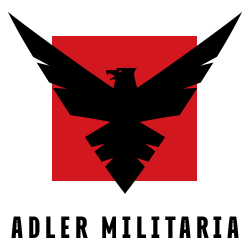Showing 37–45 of 238 resultsSorted by latest
-
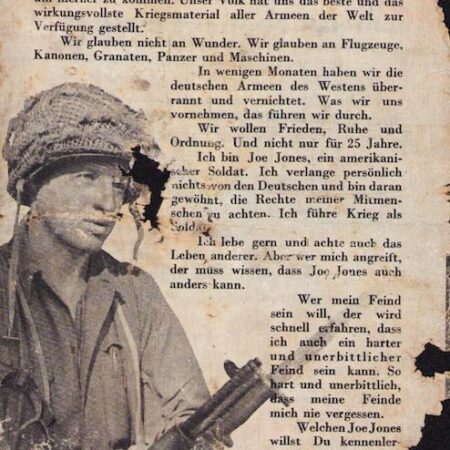
Original WWII US Propaganda for German Soldiers – German 1945 – GI Joe Jones – Rare
$55.00Here we have a rare US Army Propaganda Flyer dropped on German Positions in Germany in 1945. Translation The Americans have not changed The Americans are approaching your cities.Since your leaders have driven you into this criminal war, your armed forces will be destroyed and Germany will be occupied. The older among you may still remember the Americans from the last war. But it is also in your interest to learn about the Americans in time. This is what you must know: The Americans demand peace and order, and they will mercilessly crush disorder. The Americans will not tolerate war criminals and war prolongers. The Americans will exterminate fanatics and Nazi swindlers. Whoever understands this can get along with the Americans. Whoever does not want to must remember: As you make your bed, so must you lie in it. My name is Joe Jones I am an American soldier. I come from Steubenville in the state of Ohio. My comrades and I have made a long journey to get here. Our people have provided us with the best and most effective war material of all the armies in the world. We do not believe in miracles. We believe in airplanes, cannons, grenades, tanks, and machines. In a few months we have overrun and destroyed the German armies in the West. Whatever we set out to do, we carry through. We want peace, calm, and order. And not just for 25 years. I am Joe Jones, an American soldier. Personally, I demand nothing from the Germans and am used to respecting the rights of my fellow men. I wage war as a soldier. I enjoy life and also respect the lives of others. But whoever attacks me must know that Joe Jones can act differently. Whoever wants to be my enemy will quickly find out that I can also be a tough and merciless enemy. So tough and merciless that my enemies never forget me. Which Joe Jones do you want to get to know?
-
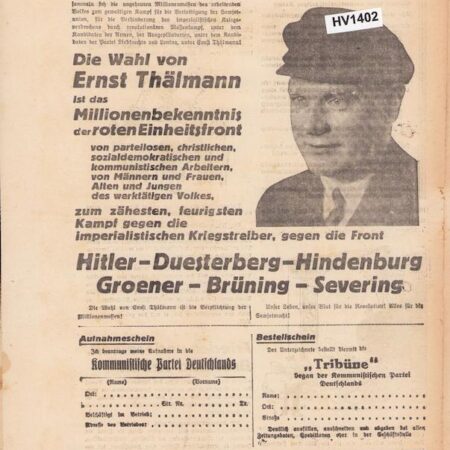
Original KPD 1932 Elections Propaganda – Ernst Thälmann – Red United Front – 4 Pages – Very Rare
$175.00German communist propaganda leaflet/newspaper from the early 1930s (Weimar Republic period, pre-Nazi takeover). It appears to have been printed by or for the KPD (Kommunistische Partei Deutschlands – Communist Party of Germany), and it is aimed at mobilizing workers against the rise of fascism (Hitler, Hindenburg, etc.) and against imperialist war preparations. Page 1 – Large headline: “Krieg” (War). References to 26 February edition of “BZ am Mittag”, describing Japanese militarism in China and imperialist wars. Sections: “Der Krieg ist da!” (The war is here!) “Jetzt höchster Alarm” (Now highest alert) – warning workers about war danger. “Die Sowjetunion ist die einzige Macht, die aktiv für den Frieden eintritt” (The Soviet Union is the only power that actively stands for peace). A photograph of a man (likely a Soviet or German communist leader). Page 2 Headline: “In der roten Einheitsfront” (In the Red United Front). Big slogan: “Die Wahl von Ernst Thälmann ist das Millionenbekenntnis der roten Einheitsfront” (The election of Ernst Thälmann is the declaration of millions for the Red United Front). Thälmann was the leader of the KPD and ran against Hitler and Hindenburg. Calls for unity of workers (Communists, Social Democrats, Christian workers, etc.) against Hitler, Duesterberg, Hindenburg, Groener, Brüning, Severing (political opponents). Bottom has: Membership application form for the Communist Party. Subscription form for the party newspaper “Tribüne”. Portrait of Ernst Thälmann with a cap. Page 3 Denounces the “Hitler–Duesterberg–Hindenburg front.” Calls to action: “Proletarier, Augen auf!” (Proletarians, open your eyes!) “Die Kommunistische Partei ruft” (The Communist Party calls). Cartoon caricatures of Hitler, Hindenburg, and another conservative politician (likely Groener). Slogan: “Noch ist es Zeit, den Kriegstreibern in den Arm zu fallen!” (There is still time to stop the warmongers!). Page 4 Headline: “Sturm im Land” (Storm in the country). Strong calls for workers’ unity against imperialist war and for defense of the Soviet Union. Specific calls to: Metalworkers, chemical workers, railway workers, seamen, dock workers, transport workers, chauffeurs. Cartoon of capitalist/bourgeois men sitting at a table drinking and eating while workers suffer. Another drawing shows dockworkers handling heavy machinery and war materials (criticizing war profiteering). Final slogans: “Frieden und Freiheit, Brot und Arbeit” (Peace and Freedom, Bread and Work). Demands for fighting capitalism, militarism, and for solidarity with the Soviet Union and revolutionary workers in China. Final Comments Communist propaganda from the KPD, around the 1932 German elections, when Ernst Thälmann ran for president against Hitler and Hindenburg. It appeals to workers to unite under the Communist Party to fight against war, militarism, and capitalism. It glorifies the Soviet Union as the only force for peace. It denounces Hitler, Hindenburg, and other right-wing/centrist leaders as “warmongers” serving big capital.
-
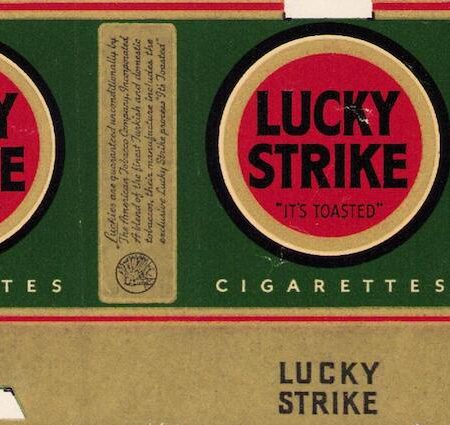
Original USA Pre-1942 WWII Lucky Strike Packet Cover
$45.00Lucky Strike packs with the green background were used before 1942. In 1942, during WWII, the company switched to the now-familiar white background — officially claiming it saved copper for the war effort, though many historians suggest it was also a clever rebranding/marketing move.
-

Original WWII German Propaganda Leaflet – Antisemitic – Rare
$75.00A really rare leaflet dropped by German Propaganda Units on Soviet Trenches to try and get them to surrender. Translation This pass is valid for an unlimited number of commanders and soldiers of the Red Army who cross over to the side of the German troops. The bearer of this, not wishing senseless bloodshed for the interests of Jews and commissars, leaves the defeated Red Army and crosses over to the side of the German Armed Forces. German officers and soldiers will receive the one crossing over well, feed him and arrange work for him. Commanders and fighters of the Red Army! Your situation is hopeless.The iron ring of German troops is tightening tighter and tighter around you.You lack ammunition, supplies, and food; your rulers and leaders are incapable of anything, they flee and abandon you to fate.Many of you have been oppressed until now, deprived of rights — now you are being used only to defend their regime. Your struggle is useless!Is it really permissible that your command, out of stubbornness, still drives you mercilessly to inevitable death?No — your life is dear! Save it for a better future and for your families. Cross over to the Germans — there you will find good treatment and food, as well as a quick return home. Hurry!In the areas occupied by them, the Germans have already begun resolving the land question. Red Army soldiers, do not delay, otherwise you will be left without land! Headline (Russian): “Beat the Jew–political commissar, his mug begs for a brick!”(antisemitic slogan, repeated twice on the page) Top image caption:“Commissars and political instructors force you into senseless resistance.” Bottom image caption:“Drive away the commissars and cross over to the Germans.Cross to the Germans using either the slogan or the pass:” Final Comments: This is an extremely rare historical item and is only sold for historical purposes. They are filled with propaganda, disinformation, and hate speech.
-
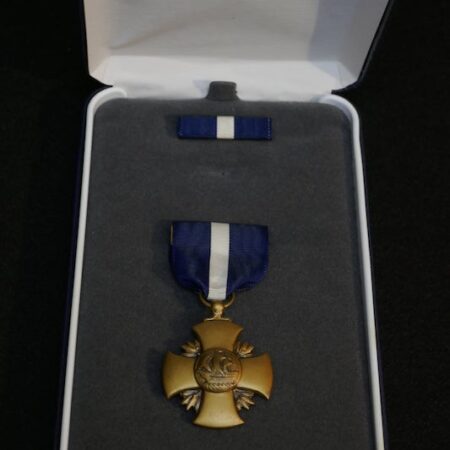
Post-WWII US Navy Cross with Issue Case
$100.00Here we have an original Navy Cross in the issue box. Price is inclusive with shipping!
-

Oil Painting by Ernst Frommhold – “Feldbergblick” – Famous Third Reich Artist – Reichsführung SS – Deutsche Kunst 1944
$995.00Here we have a rather odd item for a change! Feldbergblick by Ernst Frommhold Ernst Frommhold (* November 17, 1879 in Leipzig; † June 24, 1955 in Leipzig) was a well-known German landscape and marine painter. Ernst Frommhold came from a farming family living in the Leipzig area. After completing school, he was not allowed to study painting at the Leipzig Art Academy, as he had chosen to do, but instead had to complete an apprenticeship as a merchant and eventually became self-employed in this field. He continued the artistic pursuits he had devoted himself to since childhood in his free time. Numerous study trips took him to Italy, Switzerland, and twice on a steamship across the North Sea to the coast of Iceland. After the inflation following the First World War, he gave up his business and made his living exclusively from painting. In order to gain the necessary professional recognition, he planned to study at the Academy in Leipzig after all. There, however, he is said to have received a warning from Professor Hey that he could no longer teach him anything new and that Frommhold should simply continue as before. Frommhold was represented with six paintings at the Great German Art Exhibition in Munich in 1937, 1938, 1939, and 1940. Of these, “In the Heart of Greater Germany” was purchased by Emil Georg von Stauß, General Director of the Deutsche Bank, in 1939, and “Fertile Land” was purchased by the Reich SS leadership in 1940. In 1951, the artist moved to Karlsruhe, where he drew particular inspiration from the neighboring Black Forest in his final years. Having just recovered from a heart condition, he died unexpectedly in 1955. More information about his paintings during the TR. https://www.gdk-research.de/db/apsisa.dll/ete Price includes shipping and handling.
-
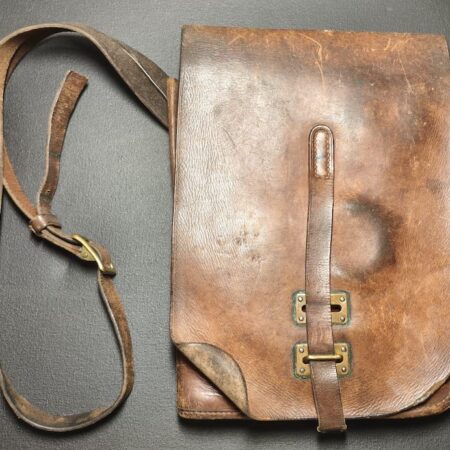
Original WWII Soviet Officers Map Case with Cross Strap – Lend-Lease – US Made – Rare
$285.00Here is a rather rare find, this is a Soviet WWII Lend-Lease US made Officers Map Case. You can see that the case is in quite good condition, the leather is still fine and great for display. There was at some period a Soviet Compass inside the imprint can be seen.
-
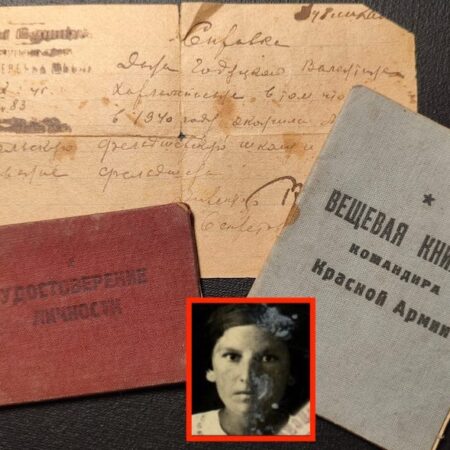
Original WWII Soviet Red Army Female Medical Officers Identity Papers – Senior Lieutenant Gadyatskaya – 137th Infantry Division RKKA – Archive Research / Photo – Rare!
$175.00Here we have a really odd find, that not often comes to the market. This set belonged to: Senior Lieutenant of the Medical Service – Valentina Gadyatskaya She served in a Military hospital and even was awarded the “Medal for Military Merit” she was still alive in the early 1990s as she was awarded the Veterans editions of the “Order of the Patriotic War 2nd Degree”. Her full information can be seen in the Red Army Online Archive, including her photo. Date of birth __.__.1922 ; 25.12.1921 Place of birth Ukrainian SSR, Donetsk region, city of Zhdanov ; Ukrainian SSR, Stalin region, city of Mariupol Place of conscription Mariupol State Military Commissariat, Ukrainian SSR, Stalin region, Mariupol Date of conscription 22.06.1941 Military rank Senior lieutenant of the medical service ; Senior lieutenant of the medical service Military unit 137th Infantry Division Awards Medal “For Military Merit” Order of the Patriotic War, 2nd degree Link to information: https://pamyat-naroda.ru/heroes/person-hero92516846/?backurl=%2Fheroes%2F%3Fadv_search%3Dy%26last_name%3D%D0%93%D0%BE%D0%B4%D1%8F%D1%86%D0%BA%D0%B0%D1%8F%26first_name%3D%D0%92%D0%B0%D0%BB%D0%B5%D0%BD%D1%82%D0%B8%D0%BD%D0%B0%26middle_name%3D%26date_birth_from%3D%26static_hash%3D17f71efbce3ede81709ecada02fbffd5b3573f3600cdbc1aa8742bd494516397v1%26group%3Dall%26types%3Dpamyat_commander%3Anagrady_nagrad_doc%3Anagrady_uchet_kartoteka%3Anagrady_ubilein_kartoteka%3Apdv_kart_in%3Apdv_kart_in_inostranec%3Apamyat_voenkomat%3Apotery_vpp%3Apamyat_zsp_parts%3Akld_ran%3Akld_bolezn%3Akld_card%3Akld_upk%3Akld_vmf%3Akld_partizan%3Apotery_doneseniya_o_poteryah%3Apotery_gospitali%3Apotery_utochenie_poter%3Apotery_spiski_zahoroneniy%3Apotery_voennoplen%3Apotery_iskluchenie_iz_spiskov%3Apotery_kartoteki%3Apotery_rvk_extra%3Apotery_isp_extra%3Asame_doroga%3Asame_rvk%3Asame_guk%3Apotery_knigi_pamyati%26page%3D1%26grouppersons%3D1&
-
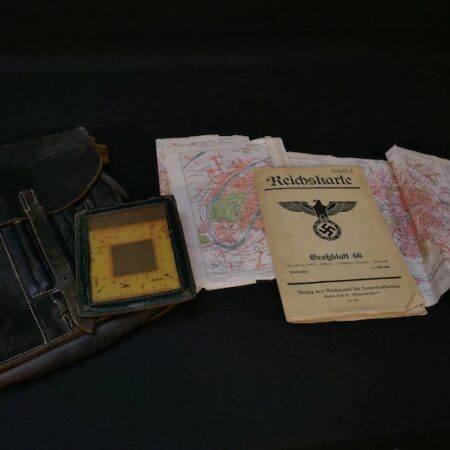
Original WWII German Army Map Case With Contents – Map Frankfurt Oder / Küstrin – Map Paris – Pencil – WaA Ruler
$375.00Here we have a very nice set as found, German Officers Map case with the contents. We decided to leave it as is, inside is a Map of Frankfurt (Oder) – Seelow Battle Area, Maps of the city of Paris and a very nice and quite rare Wehrmacht WaA Marked Ruler and pencil.
